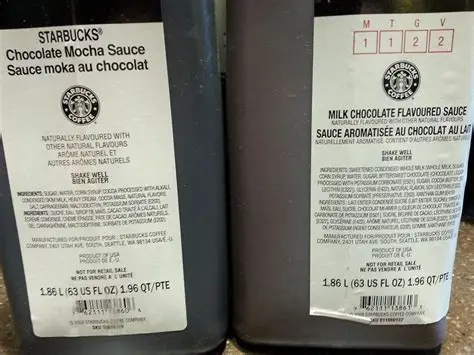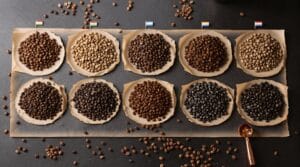Starbucks mocha sauce packs 19g sugar per pump—nearly women’s daily limit—plus 20 calories per squirt, turning lattes into candy bars. Three pumps hit 60 calories, with carbs spiking to 23g (mostly sugar) and zero nutritional value. Keto dieters get ambushed, while White Chocolate Mocha drinkers swallow 430 calories—half from sauce. Daily use adds 36,500 calories yearly, rivaling a marathon’s worth of jogging. Even Starbucks axed some mocha drinks for being too wild. This sneaky syrup proves coffee upgrades can hide wild secrets—dig deeper to dodge the sugar trap.
The Hidden Calorie Content in Each Pump
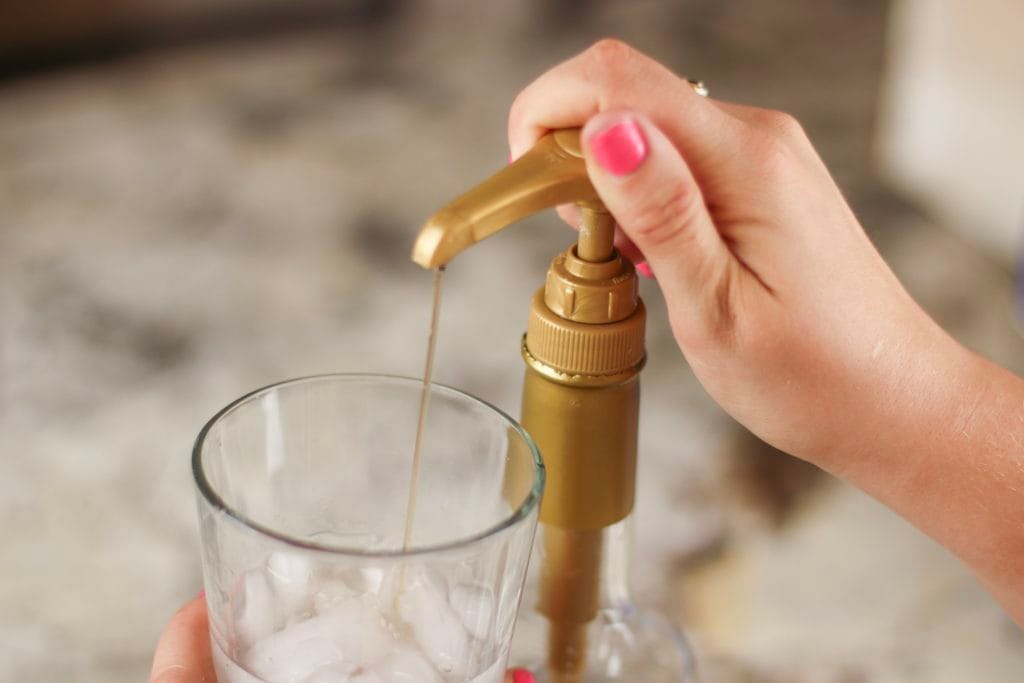
One pump of Starbucks’ mocha sauce sneaks in 20 calories—it might look tiny, but it’s a sugar ninja, hiding 3.5 grams of sweet stuff and a dash of fat in every squirt.
That single pump? A sugar ninja: 20 calories, 3.5g sweet stuff, and a stealthy fat hit—innocent squirt, sneaky stats.
For those tracking *starbucks mocha sauce nutrition*, the *calories in starbucks mocha sauce* stack fast when drinks get extra pumps. A latte with three *mocha pump starbucks* hits 60 calories, easy, turning morning joe into a snack in disguise.
Each pump’s 0.4g fat and 3.8g carbs whisper, “No big deal,” but four pumps can mean a walk around the block to burn it off. Burning those 83 kJ from just one pump requires a 6-minute brisk walk for an average adult, according to Calorie Burn Time metrics.
Want freedom? Customize smart: two pumps instead of four shaves 40 calories, trading dessert vibes for coffee freedom.
Choices are power, folks—even the tiny ones.
Shockingly High Sugar Levels per Serving
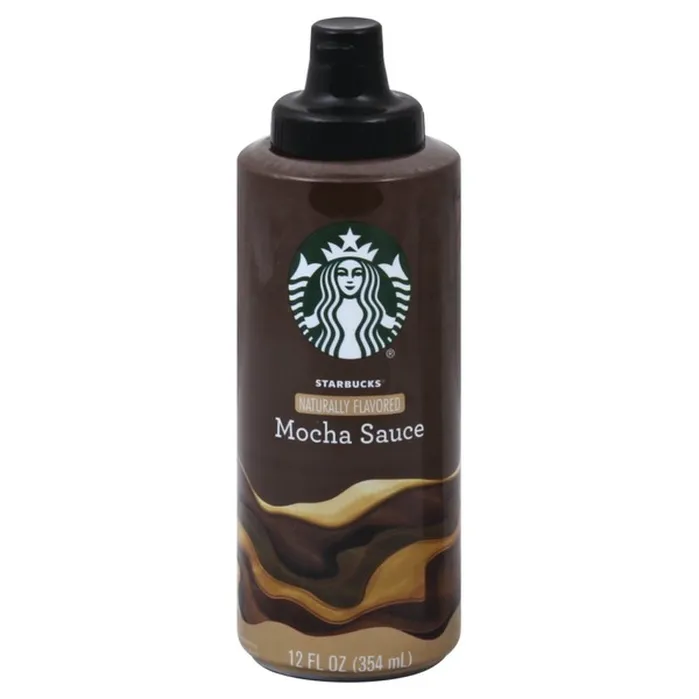
Each pump of Starbucks’ mocha sauce packs 19 grams of sugar, almost matching a woman’s daily limit per American Heart Association guidelines, acting like a sneaky sugar bomb in coffee.
That mountain of sweetness spikes blood sugar quickly, risking energy crashes and long-term insulin issues, especially for frequent drinkers. Amidst the sugar overload, one serving provides 11% daily iron, offering a small nutritional upside for blood health.
Regular use can nudge weight gain, too, piling on extra “empty” calories like unwrapped candy bars hiding in every sip.
Per Pump Sugar Content
While Starbucks’ mocha syrup adds creamy chocolate flavor to drinks, a single pump packs a surprising sugar punch—11 grams, which is like stirring nearly three spoonfuls of straight sugar into your coffee!
Each pump also hits 60 calories, mostly from sugar and fat—making “how many calories in Starbucks mocha sauce” a key question for those watching intake. For perspective, the American Heart Association’s daily added sugar limit is 25–36 grams, meaning just three pumps exceed recommendations, freedom or not. Studies show consistent overconsumption drives chronic conditions like heart disease and type 2 diabetes—both linked to high-sugar diets in recent research.
With Starbucks drinks often loaded with multiple pumps (think venti’s four+), that morning mocha could become a sugary time bomb. Tracking apps show real-time totals, so mind those pumps—or plan to jog off the sweetener splurge!
Calories in Starbucks mocha syrup add up fast, turning flavor into a stealthy diet disruptor.
Impacts Blood Sugar
Starbucks’ beloved mocha sauce packs a sugary punch, delivering nearly a day’s worth of added sugar in just a few pumps, which can send blood sugar levels soaring faster than a caffeine jolt! Here’s the bitter truth about its sweet impact:
1. Blood Sugar Rollercoaster – One serving contains *23g carbs* (mostly sugar), spiking glucose like a candy bar disguised as coffee, leading to crashes that leave you craving more.
Pump party? Think twice!
2. Insulin Overload Alert – High sugar overwhelms the body’s insulin response, forcing it to work overtime—especially risky for those with diabetes or insulin resistance.
Your pancreas is *not* a superhero!
3. Hidden Sugar Bombs – Mocha sauce sneaks into drinks like Mochas or Frappuccinos, adding up to *50g+ sugar* per drink.
That’s *double* daily limits… in one cup! Sugar in disguise!
4. Long-Term Trouble – Frequent spikes raise risks for diabetes, heart disease, and energy slumps.
Skipping the sauce? You’re dodging a bullet… *and* a sugar crash!
Sugar rush now, regrets later—know your pour!
Obesity Risk Factors
Hidden inside that sweet, velvety mocha drizzle lies a sneaky sugar rush—one tablespoon of Starbucks’ sauce packs 12 grams of sugar, enough to turn your latte into a calorie-packed treat that quietly fuels weight gain!
Just two pumps in a drink add 100 calories, mostly from sugar, hitting half the daily added sugar limit (200 calories) fast.
Regular sippers face higher obesity risks: excess sugar overloads the body with energy it stores as fat, tricks hunger hormones into craving more snacks, and messes with insulin, making weight loss tougher.
Even “light” drinks with mocha sauce add stealthy sugar, bloating calorie counts without filling you up. Additionally, a Grande Chai Latte has caffeine content of 95mg, further complicating the sugar and energy balance in beverages.
Combined with Starbucks’ menu of sweet sips, it’s a sugary cycle that packs on pounds, bite by tempting, chocolatey sip.
How It Derails Daily Carbohydrate Limits
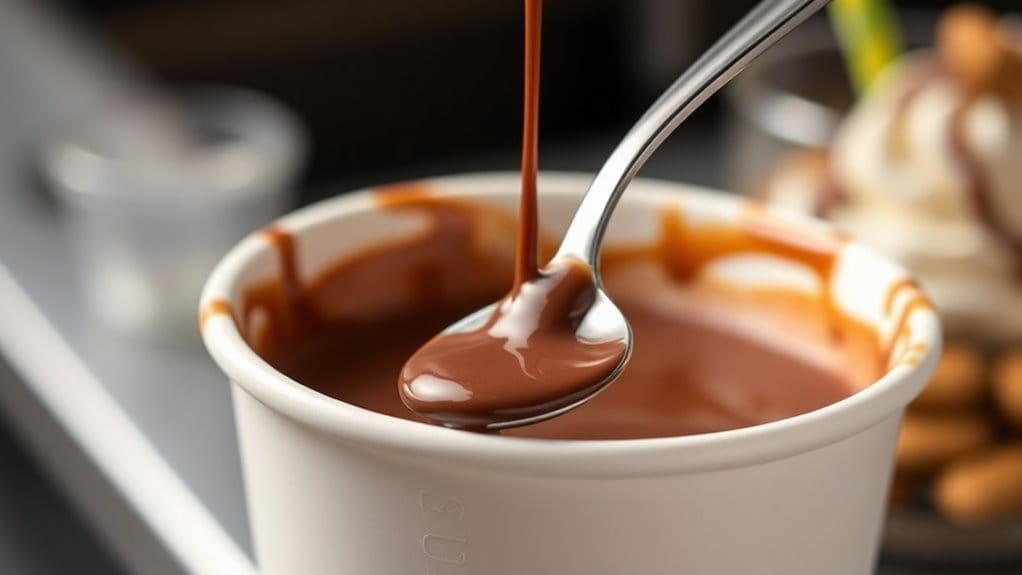
Starbucks Mocha Sauce hides a carb bomb, with just 2 tablespoons packing 23g of carbs—nearly matching the carbs in a medium apple, sneaking into drinks unnoticed.
The 19g of sugar per serving acts like a sugar-fueled rocket, blasting past daily carb limits in one creamy latte, leaving little space for healthier carbs like rice or veggies.
While delicious, this stealthy sugar can spike blood sugar fast, disrupt low-carb diets, and turn that morning pick-me-up into a math problem for your nutrition goals. Furthermore, the high sugar content can overshadow the nutritional benefits associated with coffee, making it crucial to monitor intake carefully.
Hidden Carb Content
A sweet drizzle in your morning coffee might seem harmless, but just two tablespoons of mocha sauce pack 23 grams of carbs—almost a full day’s allowance for someone on keto! Its sugary punch hides in plain sight, turning a “light” treat into a carb bomb.
- Stealthy Sweetness: 19g of the carbs come straight from sugar—like pouring 4.5 packets of sugar into your drink, but it’s disguised as fancy coffee sauce!
- Keto Kryptonite: At 22g net carbs per serving, one pump could shatter keto goals, leaving little room for veggies, nuts, or other carb-cautious eats.
- Portion Deception: Just 2 tbsp (about 30g) seems tiny, but multiply that for lattes or frappuccinos, and you’re sipping a carb avalanche.
- Glycemic Sneak Attack: Zero fiber to slow the sugar rush means energy crashes or cravings, especially tricky for blood sugar watchers.
Rapid Sugar Intake
That sneaky drizzle in coffee doesn’t just blow carb counts—it rockets sugar straight into the bloodstream like a candy-fueled spaceship.
One pump of Starbucks mocha sauce packs 5g of sugar, so a drink using three pumps launches 15g instantly, spiking glucose and forcing the pancreas into emergency insulin production. This sugar rollercoaster leads to energy crashes, hunger rebounds, and cravings for more carbs, derailing daily intake goals before lunch.
FDA’s 25-36g daily sugar limit? A single grande mocha can hit 50g, hijacking your carb budget, leaving no room for nutrient-dense foods.
Worse, liquid sugar tricks the brain with dopamine hits, fueling addiction-like cycles. Over time, repeated sugar surges strain metabolism, inviting insulin resistance, obesity, or worse—all for a fleeting sweet buzz.
The Misleading Fat and Protein Ratios
One pump of Starbucks mocha syrup, while adding sweet flavor to drinks, hides a sneaky secret—nearly 80% of its calories come from sugar, with fat and protein barely making a dent.
The sauce’s macros are wildly unbalanced, leaving drinkers with sugary spikes and little nutritional payoff.
Sugar rush reality: Carbs dominate, sugars spike, while fats and proteins ghost the party—nutritional value MIA in this syrupy sip.
- Carb Overload: At 23g of carbs per serving—19g from sugar—it’s like eating 4.5 packets of sugar, while fat (0.5g) and protein (1g) sit on the bench, doing nothing.
- Protein Illusion: The 1g of protein is less than a baby carrot provides, making its “muscle fuel” claim laughable—this sauce isn’t bench-pressing anything.
- Fat Fantasy: With microscopic fat content, it skips healthy fats (like avocado’s), sacrificing nutrition for sweetness.
- Label Lure: The numbers suggest balance, but it’s like a movie trailer—editing out the sugar chaos to sell a “health-ish” vibe.
Its Incompatibility With Keto and Low-Carb Diets
Starbucks’ mocha sauce isn’t just a sugar bomb — it’s a keto nightmare. Each pump packs 5g sugar, blasting past keto’s 20-30g daily carb limit.
Pair that with milk’s lactose, and a single drink can hit 30g carbs, yanking you out of fat-burning mode.
Sugar-free versions cut carbs, but some keto fans ditch artificial sweeteners, fearing stalled progress.
Want a workaround? Swap sauce for sugar-free, add heavy cream, but still count carbs like cash.
Baristas auto-pump mocha unless you bark, “hold the sauce!”
Hidden carbs lurk in every sip, tricking keto enthusiasts into carb overload.
One misstep — a sweet sip, a silent pump — and ketosis waves goodbye.
Freedom from sugar traps? Only with sharp eyes and bold orders.
Zero Essential Nutrients Despite the Calories
Starbucks Mocha Sauce delivers around 100 calories per serving but provides no vitamins, minerals, or other nutrients that support your health.
Each serving packs 19-22g of sugar and zero fiber, making it an “empty calorie” choice that adds sweetness without nutrition.
It’s like a sugary motor revving your energy tank—but without protein, fiber, or vitamins to actually fuel your body, you’re left with just a sweet buzz!
No Essential Vitamins
Despite its velvety flavor improvement, Starbucks’ mocha sauce skips the vitamin party entirely, serving up 100 calories per two-tablespoon pour without delivering any Vitamin A, C, D, or other essential nutrients.
It’s like a dessert disguise—sweet, creamy, but nutritionally barren. Here’s the breakdown:
- 🥛 Vitamin-Free Zone: No detectable Vitamin A for vision, Vitamin C for immunity, or Vitamin D for bones—just a chocolate-flavored void.
- 🧪 No B-Complex Boost: Missing B vitamins that help convert food to energy, leaving your body hanging mid-metabolism.
- 🌱 Zero Fortification Fun: No added vitamins (unlike fortified cereals or milk), just sugar, cocoa, and a shrug from your cells.
- 🤷♀ Nutrient Neutrality: Even trace minerals like calcium and iron clock in under 2% daily value—about as impactful as a sprinkle of glitter.
Crave flavor? Done. Crave nutrients? Grab a carrot.
Empty Calorie Source
While it might taste like a hollow chocolate shell of deliciousness, the mocha sauce packs a sneaky punch of calories without bringing any real nutrition to the table!
A single 30-gram serving delivers around 100 calories, with 19–22 grams of sugar—a sugar bomb hiding under that chocolaty disguise.
It’s got almost no protein (just 1 gram!) and barely any fat (0.5 grams), leaving you with empty carbs that don’t fuel muscle, support metabolism, or keep you full.
The sauce skips vitamins, minerals, and antioxidants, making it a poster child for “calorie without purpose.”
Want to burn those 100 calories? Plan a 25-minute walk—talk about a sugar tax!
For those prioritizing freedom in their diet, mocha sauce is like that fun but unreliable friend: delightful in the moment, but zero long-term benefits.
Zero Dietary Fiber
A splash of sweetness hiding a nutritional ghost town, Starbucks’ mocha sauce delivers 100 calories per squirt but skips the essentials. This syrupy add-on fuels your drink with sugar-fueled energy while leaving fiber out of the party, making it a flavor bomb with zero gut-friendly perks.
- Zero Fiber Frenzy: Each pump lacks dietary fiber — just 1g per serving — so it won’t help your digestion or keep you full, turning your latte into a sugar coaster ride.
- Blood Sugar Speedrun: With no fiber to slow things down, its 22g net carbs hit fast, spiking energy (and crashes) like a toddler on a cupcake binge.
- Vitamin Vanish: Calcium? Iron? Micronutrients? Barely there. Even a raisin packs more nutritional punch.
- Whole Food Foil: Unlike real cocoa or fruit, this sauce’s stripped of fiber and nutrients, trading health for hype.
Bottom line: It’s your taste buds’ VIP pass, your body’s ghost town, and gut health’s worst pen pal.
The Role in Popular High-Calorie Starbucks Drinks
Starbucks’ mocha sauce plays a starring role in transforming coffee into sweet, indulgent treats loved by many, adding flavor but piling on calories, sugar, and a bit of caffeine.
Think of drinks like the White Chocolate Mocha (430 calories) or Mocha Frappuccino (370 calories)—mocha sauce is their secret weapon, blending chocolatey sweetness with stealthy calorie enhancements.
Starbucks’ mocha sauce stealthily elevates drinks like White Chocolate Mocha and Mocha Frappuccino, sneaking in sweetness—and extra calories—with each decadent drizzle.
Each pump adds 20-25 calories, and most drinks use multiple pumps, turning simple coffee into dessert-like sips.
Toppings like whipped cream or extra drizzle tack on 15-110 more calories, making these drinks sneaky sugar bombs (up to 53 grams of sugar!).
Even the caffeine boost is modest, around 9 mg per pump—enough to perk up your taste buds, not your energy.
Want freedom? Customize wisely, or your morning pick-me-up might out-eat a slice of cake!
Cumulative Impact on Weight Gain Over Time
Toppings and flavor twists might seem harmless in a single coffee, but those mocha sauce pumps add up fast, like a car collecting dust bunnies on a road trip. A daily splash of sweetness can snowball into sneaky, long-term weight changes, quietly hijacking goals.
- Game of numbers: Two tablespoons of mocha sauce pack 100 calories — add that daily, and you’ll rack up 36,500 extra calories in a year, enough to gain 10 pounds without exercise.
- Sugar avalanche: With 19g sugar per serving, it’s like dumping a candy bar into your cup, fueling cravings and insulin spikes that store fat faster.
- Exercise illusion: Burning those 100 calories requires 11 minutes of walking — but who tracks that? Most don’t, letting calories pile up.
- Slow creep: Tiny indulgences, harmless today, build into yearly weight gain, like pennies adding up to a fortune nobody wants.
The math doesn’t lie: small choices ripple into big consequences.
Why It’s Not as “Light” as Advertised
That “light” mocha syrup might trick taste buds, but nutrition labels tell a different story. A single 30-gram serving packs about 23 grams of carbs, mostly sugar—equivalent to 100 calories!
Corn syrup and invert sugar spike blood sugar fast, making the “light” claim feel like a sneaky magician’s trick. While it’s low in fat (just 0.5g), sugar does the heavy lifting, turning that innocent coffee drizzle into a calorie bomb.
Portion sizes add to the illusion: drinks often use multiple pumps, hiding the total sugar rush. Preservatives like potassium sorbate keep it shelf-stable, but antioxidants? Gone with processed cocoa.
It’s like getting confetti instead of confetti cake—colorful, fun, but not filling. Check labels, skip the hype.
The Surprising Reason It’s an Archived Product
When a syrup is too unique for its own good, it risks getting benched—like the mocha sauce tied to Starbucks’ discontinued Mocha Valencia.
- One-Drink Wonder: The tangerine syrup in Mocha Valencia was *only* used in that drink, creating inventory headaches—imagine buying a whole pineapple just to eat one slice.
- Costly Complexity: Exclusivity jacked up costs, making it cheaper to ditch the drink than keep training baristas on niche recipes, like tossing a puzzle missing half its pieces.
- Flavor Fickleness: Chocolate-orange combo wasn’t a crowd-pleaser, so sales flopped—think of it as socks-and-sandals taste: bold, but not for everyone.
- Shelf-Life Stress: Uncommon syrups spoil faster, pushing Starbucks to purge fussy ingredients, like decluttering a fridge full of expired condiments.
Sometimes, even tasty ideas get retired when practicality screams louder than passion.
Frequently Asked Questions
Does Starbucks Mocha Sauce Contain Artificial Flavors or Preservatives?
Starbucks mocha sauce contains natural flavor ingredients without explicitly declared artificial flavors. It includes preservatives like potassium sorbate and citric acid for stability, as common in commercial syrups. Full ingredient details are publicly disclosed.
How Does Mocha Sauce Compare to Other Starbucks Syrup Options?
Starbucks Mocha Sauce is calorically denser, with higher carbohydrates and sugar per serving compared to syrups. Its creamier texture and chocolate content contrast syrups’ liquid consistency and flavor variety. Syrups better suit low-carb dietary preferences.
What Is the Shelf Life of Starbucks Mocha Sauce After Opening?
Like a fleeting sunrise, Starbucks mocha sauce’s peak freshness lasts 24 hours post-opening without refrigeration, starkly contrasting caramel sauce’s fortnight longevity. Rapid turnover guarantees quality, demanding prompt use after that brief window concludes.
Is Starbucks Mocha Syrup Available for Purchase in Retail Stores?
Starbucks Mocha Syrup is sold in retail stores like Target and Walmart as beverage syrups or bottled drinks. Options include multiple packaging sizes, pickup, and delivery. Pricing varies by format and retailer.
Can Mocha Sauce Be Used in Non-Coffee Recipes for Flavoring?
Like liquid velvet, Starbucks mocha sauce weaves its cocoa-infused allure into desserts, milkshakes, or breakfast dishes, granting culinary adventurers freedom to paint sweetness across diverse creations beyond coffee’s canvas.
References
- https://www.calorieking.com/gb/en/foods/f/calories-in-toppings-bar-mocha-sauce-1-pump-12-fl-oz/Z6lb0_ZwR5W6KD4F6zN4mA
- https://portionsmaster.com/blog/the-shocking-truth-about-calories-in-starbucks-coffee-drinks/
- https://www.mynetdiary.com/food/calories-in-1-pump-white-mocha-syrup-by-starbucks-pump-20375467-0.html
- https://www.nutritionvalue.org/Mocha_sauce_by_Starbucks_Coffee_Company_681212_nutritional_value.html
- https://lattecalories.com/brewing/exploring-the-calories-in-starbucks-syrups-and-flavors
- https://nutrifusion.com/the-dirty-truth-about-starbucks/
- https://www.mynetdiary.com/food/calories-in-mocha-sauce-by-starbucks-tbsp-21441320-0.html
- https://www.scribd.com/document/718706275/Writing-and-Representing-Qualitative-Research
- https://www.mynetdiary.com/food/calories-in-mocha-syrup-by-starbucks-pump-30488457-0.html
- https://www.carbmanager.com/food-detail/md:5cbf58c8601ec1434e9a85aa12cf3804/1-pump-white-mocha-syrup

